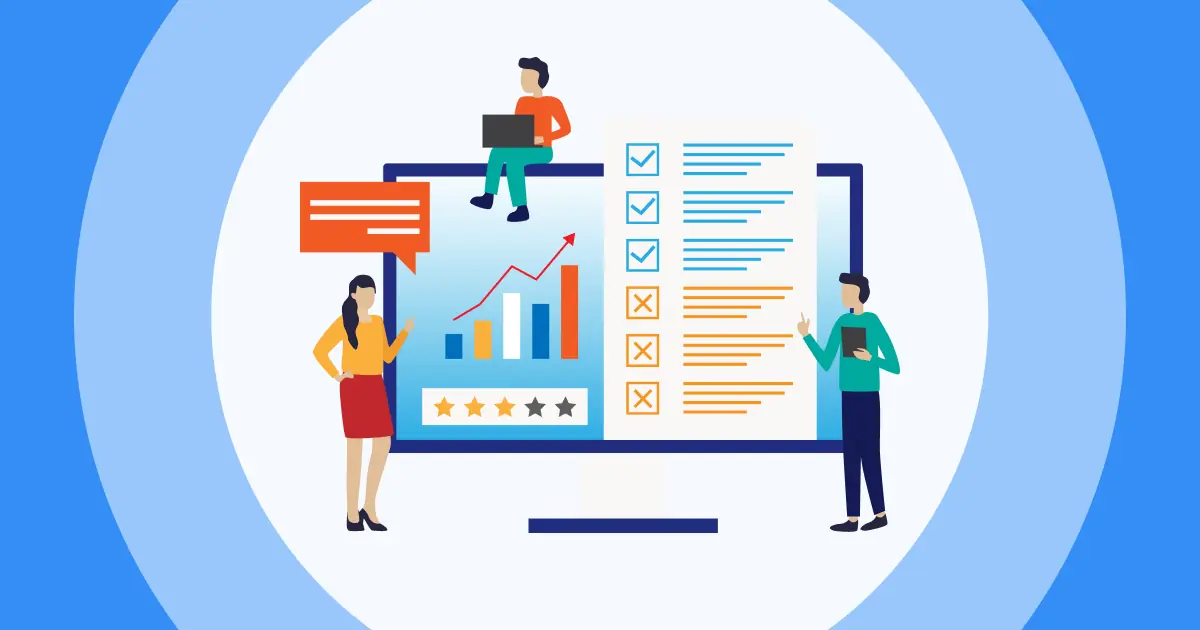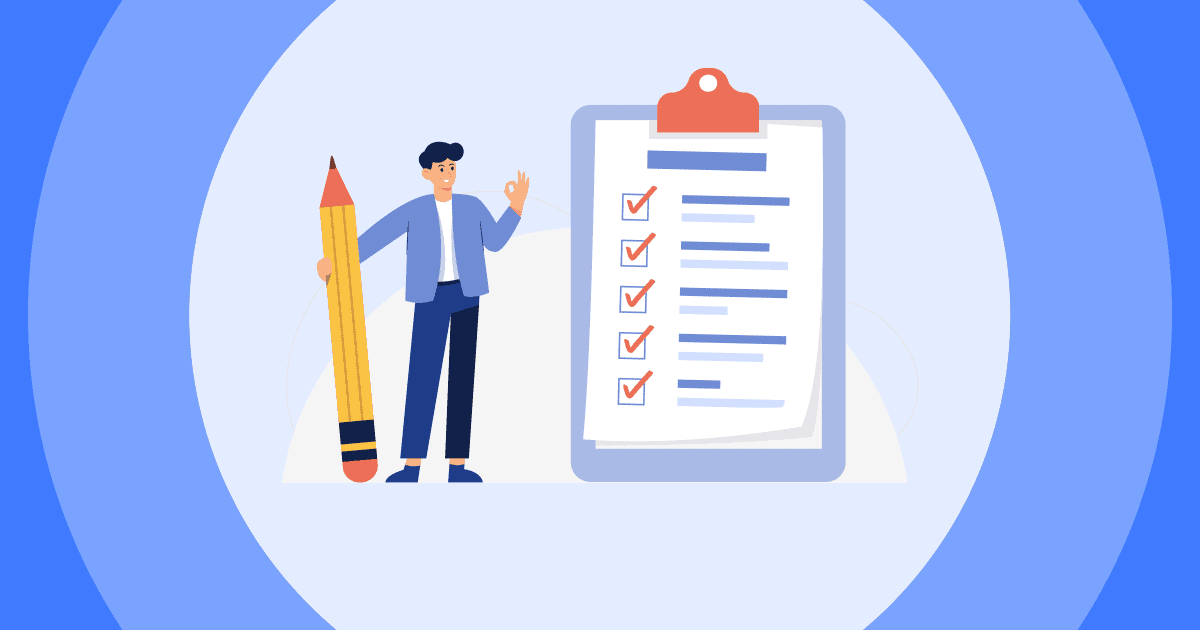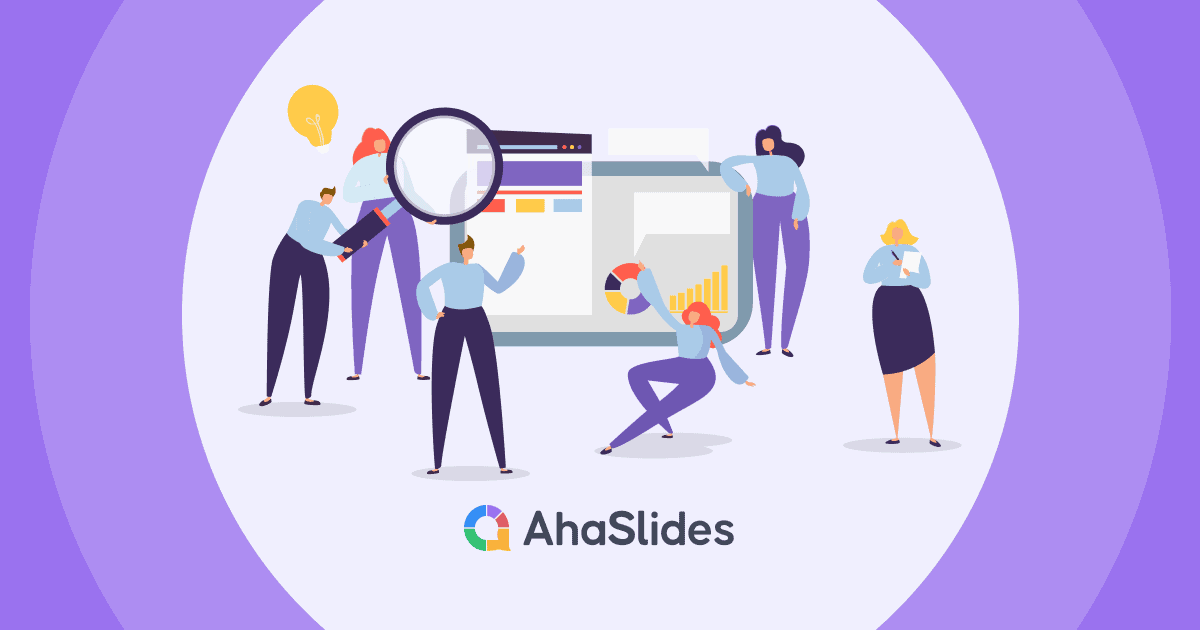制定有效的員工敬業度調查並非只是簡單地問一句「你對工作滿意嗎?」就萬事大吉了。最好的調查能夠精準地揭示團隊在哪些方面表現出色,以及在哪些方面他們正在悄悄流失,以免為時過晚。
在本綜合指南中,您將發現如何建立真正能夠推動變革的員工敬業度調查,其中包含 60 多個按類別組織的經過驗證的問題、蓋洛普和領先的人力資源研究人員的專家框架,以及將反饋轉化為行動的實用步驟。
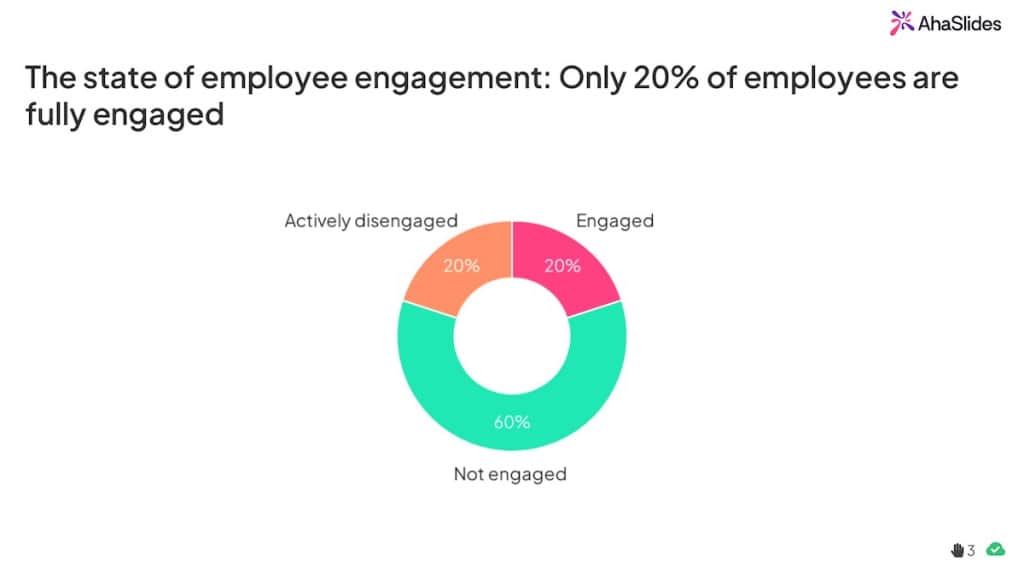
➡️ 快速導航:
什麼是員工敬業度調查?
員工敬業度調查衡量員工對工作、團隊和組織的投入程度。與滿意度調查(衡量員工的滿足感)不同,敬業度調查評估以下內容:
- 熱情 日常工作
- 校準 公司使命
- 願意 做得更好
- 打算繼續留任 長期
根據蓋洛普公司長達75年、涵蓋50多個不同產業的廣泛研究,敬業的員工能夠推動組織取得更好的績效成果(蓋洛普)
對企業的影響: 當企業衡量並改善員工敬業度時,他們會發現生產力提高、員工留任率增強以及客戶忠誠度提升(Qualtrics然而,只有五分之一的員工完全投入工作(ADP),這代表著對那些把握住這一機會的公司而言,是一個巨大的機會。
為什麼大多數員工敬業度調查都失敗了
在深入探討如何創建問卷之前,讓我們先來探討為什麼這麼多組織在員工敬業度提升方面舉步維艱:
常見陷阱:
- 調查疲勞,卻無所作為許多組織將調查視為走過場,未能對回饋採取有意義的行動,這導致了憤世嫉俗和未來參與的降低(LinkedIn)
- 匿名性混亂員工常常將保密性與匿名性混淆——雖然回覆可能是以保密方式收集的,但領導層仍然能夠識別出是誰說了什麼,尤其是在較小的團隊中(堆棧交易所)
- 通用的一刀切方法使用不同問題和方法的現成問卷會使結果難以比較,並且可能無法解決貴組織面臨的具體挑戰(LinkedIn)
- 沒有明確的後續計劃組織必須透過證明員工回饋受到重視並得到採納來贏得徵求員工意見的權利(ADP)
員工敬業度的三個向度
根據卡恩的研究模型,員工敬業度體現在三個相互關聯的維度:
1. 身體接觸
員工的表現-他們的行為、態度以及對工作的投入程度。這包括他們帶到工作場所的體力和腦力。
2. 認知參與
員工對自身角色對長期策略的貢獻的理解程度,以及他們對自己工作對組織成功的重要性的感受。
3. 情感投入
員工對組織的歸屬感和連結感—這是永續員工敬業度的基礎。
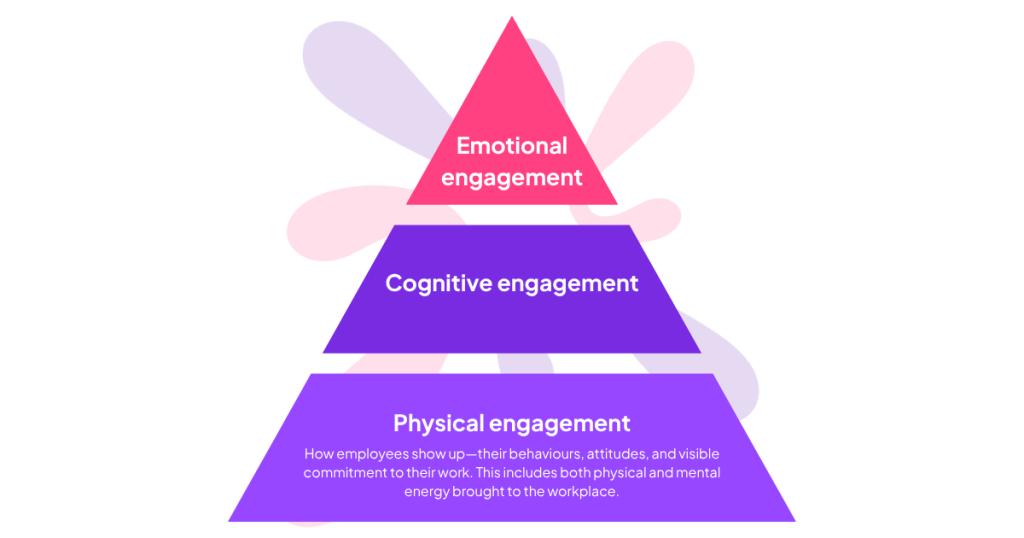
員工敬業度的12個要素(蓋洛普Q12框架)
蓋洛普經過科學驗證的 Q12 員工敬業度調查包含 12 個項目,這些項目已被證明與更高的績效結果相關(蓋洛普這些要素呈層級式遞進:
基本需求:
- 我知道工作中對我的期望是什麼。
- 我擁有做好工作所需的材料和設備。
個人貢獻:
- 在工作中,我每天都有機會做我最擅長的事。
- 在過去的七天裡,我因出色工作而受到表揚或認可。
- 我的主管或其他同事似乎很關心我這個人。
- 工作上有人鼓勵我發展
團隊合作:
- 在工作中,我的意見似乎很重要。
- 公司的使命或宗旨讓我覺得我的工作很重要。
- 我的同事們致力於做好工作。
- 我在工作上有一個最好的朋友。
成長:
- 過去六個月裡,有位同事和我談過我的進度。
- 過去一年,我在工作中獲得了學習和成長的機會。
60多個員工敬業度調查問題(按類別劃分)
精心設計的結構——按直接影響員工敬業度的主題分組——有助於發現員工在哪些方面表現出色,以及在哪些方面存在障礙(跳躍體以下是經過實戰檢驗的問題,並按關鍵參與驅動因素進行了分類:
領導與管理(10題)
使用 5 分制評分標準(從非常不同意到非常同意):
- 我的主管給了明確的指示和期望。
- 我對高階領導的決策有信心。
- 領導階層會公開溝通公司的變化。
- 我的經理會定期提供我實際可行的回饋。
- 我從我的直接主管那裡得到了我需要的支持。
- 高階管理人員表現出對員工福祉的關心
- 領導階層的行為與公司所宣稱的價值觀相符。
- 我相信我的經理會支持我的職涯發展。
- 我的主管認可並讚賞我的貢獻。
- 領導讓我感到自己身為員工的價值。
職涯成長與發展(10個問題)
- 我在這個組織有明確的晉昇機會。
- 過去六個月裡,有人討論過我的職業發展。
- 我有機會接受職業發展所需的培訓。
- 我的工作幫助我培養對未來至關重要的技能。
- 我收到了很有意義的回饋,這有助於我進步。
- 工作中有一位同事積極地指導或輔導我。
- 我在這裡看到了清晰的職業發展路徑。
- 公司投資我的職業發展
- 我有機會參與具有挑戰性、以成長為導向的專案。
- 我的經理支持我的職業目標,即使這些目標需要我到我們團隊以外的地方發展。
目的與意義(10 個問題)
- 我明白我的工作如何為公司目標做出貢獻
- 公司的使命讓我覺得我的工作很重要。
- 我的工作與我的個人價值觀相符。
- 我為能在這個組織工作而感到自豪。
- 我相信我們提供的產品/服務。
- 我的日常工作與比我自身更宏大的事物息息相關。
- 這家公司對世界產生了正面的影響。
- 我推薦這家公司,它是一個非常好的工作場所。
- 我很興奮地告訴其他人我的工作地點。
- 我的工作讓我感到很有成就感。
團隊合作(10個問題)
- 我的同事們致力於做好工作。
- 我可以依靠我的團隊成員給予支持。
- 各部門之間公開分享資訊。
- 我的團隊合作融洽,能夠很好地解決問題。
- 我感覺在團隊會議上能夠自如地表達自己的意見。
- 各部門之間合作密切
- 我的團隊成員彼此尊重。
- 我與同事建立了有意義的關係。
- 我的團隊共同慶祝成功。
- 我的團隊會以建設性的方式處理衝突。
工作環境與資源(10個問題)
- 我擁有做好工作所需的工具和設備。
- 我的工作量在可控範圍內,也比較實際。
- 我完成工作的方式比較有彈性。
- 實體/虛擬工作環境有助於提高生產力。
- 我能獲取完成工作所需的信息
- 技術系統促進而非阻礙我的工作
- 流程和程序合理高效。
- 我不會因為不必要的會議而感到不堪重負。
- 資源在各團隊之間公平分配。
- 公司為遠距/混合辦公提供了充分的支援。
表彰與獎勵(5個問題)
- 當我出色完成工作時,我會得到認可。
- 我的薪酬與我的職位和職責相符,屬合理。
- 表現優異者會得到相應的獎勵。
- 我的貢獻得到了領導階層的認可。
- 公司認可個人和團隊的成就。
健康與工作生活平衡(5個問題)
- 我可以保持健康的工作與生活平衡
- 公司真心關心員工福祉
- 我很少會因為工作而感到筋疲力盡。
- 我有充足的休息時間和精力來恢復。
- 我的工作壓力程度是可以控制的。
參與度指標(結果問題)
這些指標應放在最前面作為核心指標:
- 您有多大可能向他人推薦這家公司作為工作場所(0-10 分)?
- 我希望兩年後能在這裡工作。
- 我積極主動,願意為基本工作要求以外的職責做出貢獻。
- 我很少考慮去其他公司找工作。
- 我熱愛我的工作。
如何設計一份有效的員工敬業度問卷
1.設定明確的目標
在建立問題之前,請先定義:
- 你想解決什麼問題?
- 您將如何處理結果?
- 誰需要參與行動計畫的製定?
如果組織不了解調查的目的,就有可能浪費資源進行調查,卻無法取得有意義的改善(Qualtrics)
2. 保持專注
問卷長度指南:
- 脈衝調查 (每季):10-15 個問題,5-7 分鐘
- 年度綜合調查30-50題,15-20分鐘
- 始終包括:2-3個開放式問題,用於獲取定性見解
各組織越來越多地按季度或月度進行脈搏調查,而不是僅依賴年度調查(Qualtrics)
3. 誠實設計
確保心理安全:
- 事先明確保密性和匿名性的區別
- 對於人數少於 5 人的團隊,請彙總結果以保護身分資訊。
- 允許在線上問答中匿名提問
- 營造一種真正歡迎回饋的文化。
經驗之談: 使用 AhaSlides 等第三方平台可以在受訪者和領導層之間增加一層隔離,從而鼓勵更誠實的回答。
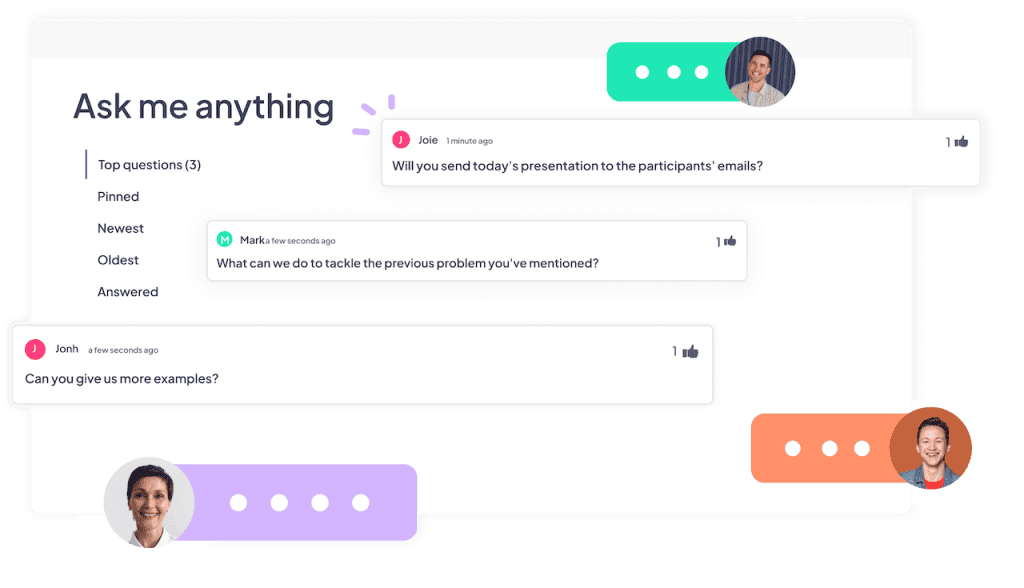
4. 使用一致的評分標準
推薦比例: 五點李克特量表
- 強烈反對
- 不同意
- 中性
- 同意
- 非常同意
另一種方法: 淨推薦值 (eNPS)
- “請以 0 到 10 分來評價您有多大可能向他人推薦這家公司作為工作場所?”
例如,+30 的 eNPS 看起來可能很強,但如果您上次的調查得分是 +45,則可能存在值得調查的問題(跳躍體)
5. 建立您的調查流程
最佳順序:
- 簡介(目的、保密性、預計時間)
- 人口統計資料(可選:職務、部門、任期)
- 核心參與問題(按主題分組)
- 開放式問題(最多 2-3 個)
- 謝謝 + 後續步驟時間表
6. 加入策略性開放式問題
例子:
- “為了改善您的體驗,我們應該開始做哪一件事?”
- “我們應該停止做的一件事是什麼?”
- “哪些方面做得好,我們應該繼續保持?”
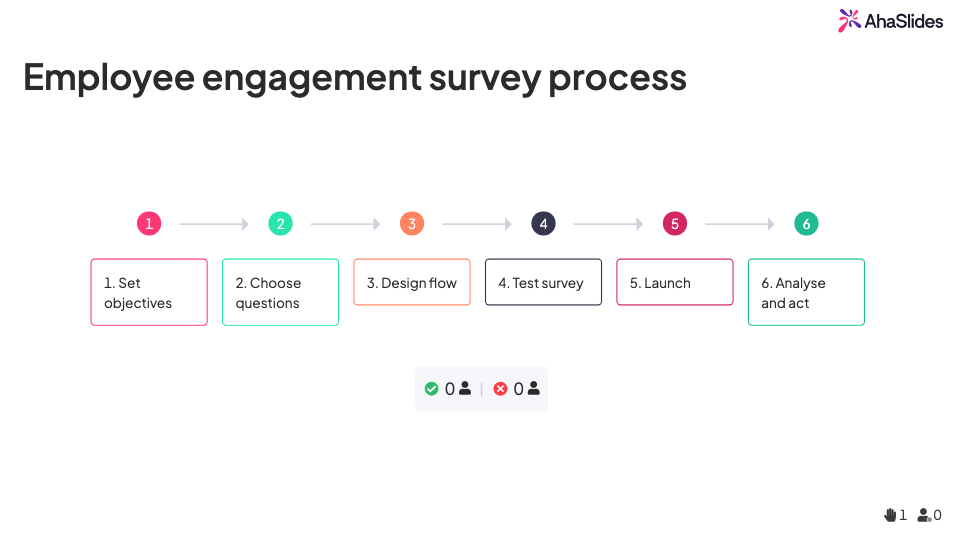
分析結果並採取行動
理解並採納員工回饋對於培養蓬勃發展的公司文化至關重要(跳躍體以下是您的調查後行動框架:
第一階段:分析(第 1-2 週)
尋找:
- 整體參與度評分 與行業基準相比
- 類別得分 (哪些維度最強/最弱?)
- 人口差異 (某些團隊/任期群體之間是否有顯著差異?)
- 開放式主題 評論中出現了哪些模式?
使用基準測試: 將您的結果與來自成熟資料庫的相關行業和規模類別基準進行比較(量子工作場所)了解你的處境。
第二階段:分享結果(第 2-3 週)
透明度建立信任:
- 與整個組織分享總結結果
- (如果樣本量允許)向管理人員提供團隊層面的結果。
- 既要肯定優勢,也要肯定挑戰
- 承諾具體的後續跟進時間表
第三階段:制定行動計畫(第3-4週)
這項調查並非終點,而只是開始。其目的是為了開啟管理者和員工之間的對話(ADP)
框架:
- 確定2-3個優先領域 (不要試圖解決所有問題)
- 組建跨職能行動團隊 (包括各種不同的聲音)
- 設定具體的、可衡量的目標 (例如,「在第二季將清晰方向評分從 3.2 提高到 4.0」)
- 指定負責人和時間表
- 定期報告進度
第四階段:採取行動與衡量(持續進行)
- 透過清晰的溝通來落實改變。
- 每季度進行脈搏調查以追蹤進展情況
- 公開慶祝勝利
- 根據有效方法迭代改進
透過向員工展示他們的回饋如何產生具體影響,組織可以提高員工參與度並減少調查疲勞(ADP)
為什麼選擇 AhaSlides 進行員工敬業度調查?
要創建員工真正願意填寫的、引人入勝的互動式問卷,需要合適的平台。 AhaSlides 如何改變傳統的調查經驗?
1.即時參與
與靜態調查工具不同,AhaSlides 能夠建立動態問卷。 互動式調查:
- 實時詞雲 將集體情緒視覺化
- 實時結果 收到回復後會顯示出來
- 匿名問答 後續問題
- 互動式體重計 感覺不像在做作業
用例: 在市政廳會議上進行參與度調查,即時顯示匿名結果,以引發即時討論。
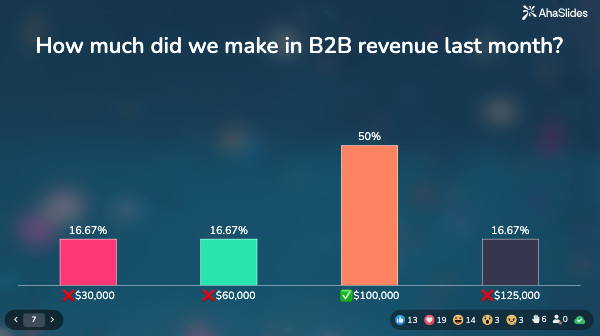
2. 多種響應管道
在員工所在的地方與他們互動:
- 支援行動裝置(無需下載應用程式)
- 現場會議的二維碼訪問
- 與虛擬會議平台集成
- 為無固定辦公人員提供的桌面和自助服務終端選項
結果: 員工可以使用自己喜歡的設備進行回复,參與率更高。
3. 內建匿名功能
解決調查中排名第一的問題:
- 無需登入(透過連結/二維碼存取)
- 結果隱私控制
- 總結報告,保護個人回應
- 可選的匿名開放式回答
4. 為行動而設計
除了收款之外,還要推動業績成長:
- 匯出資料 匯出為 Excel/CSV 檔案以便進行更深入的分析
- 視覺化儀表板 使結果易於掃描
- 演示模式 在團隊範圍內分享研究結果
- 追蹤變更 在多輪調查中
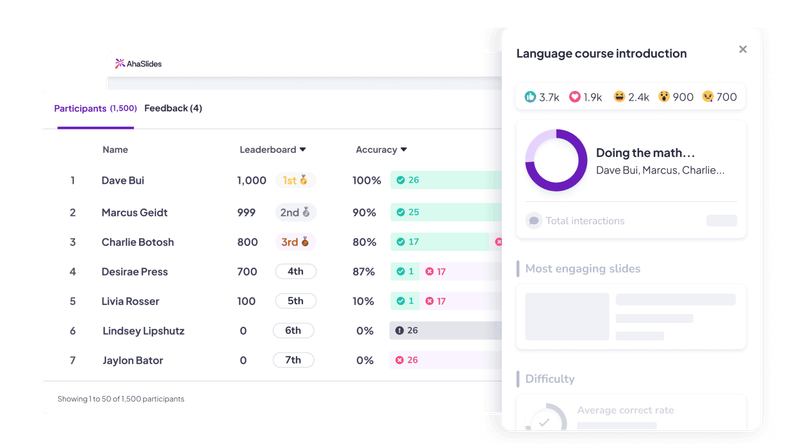
5. 快速入門模板
不要從零開始:
- 預建 員工敬業度調查 模板
- 可自訂題庫
- 最佳實踐架構(例如蓋洛普Q12問卷)
- 行業特定修改
關於員工敬業度調查的常見問題
我們應該多久進行一次員工敬業度調查?
領先的組織正在從年度調查轉向更頻繁的脈搏調查——每季甚至每月一次——以便與快速變化的員工情緒保持聯繫(Qualtrics推薦節奏:
+ 年度綜合調查:30-50 個問題,涵蓋所有方面
+ 每季脈搏調查:針對特定主題的 10-15 個問題
+ 事件觸發式調查:重大變革之後(重組、領導層更迭)
怎樣的員工敬業度調查回覆率才算好?
記錄到的最高組織回應率為 44.7%,目標是至少達到 50%(華盛頓州立大學業界標準:
+ 60%+: 優秀
+40-60%:好
+ <40%令人擔憂(顯示缺乏信任或調查疲勞)
提高回覆率的方法:
+領導階層認可
+ 多重提醒通訊
+ 工作時間內可訪問
+ 先前已證明能夠根據回饋採取行動
員工敬業度問卷的架構應該包含哪些內容?
有效的調查包括:引言和說明、人口統計資訊(可選)、參與性陳述/問題、開放式問題、其他主題模組以及帶有後續時間表的結論。
員工敬業度調查應該持續多久?
員工敬業度調查的問題數量可能從 10-15 個(用於快速調查)到 50 個以上(用於全面的年度評估)不等(啊哈幻燈片關鍵在於尊重員工的時間:
+ 脈衝調查5-7分鐘(10-15個問題)
+ 年度調查:最多 15-20 分鐘(30-50 題)
+ 一般規則每個問題都應該有明確的目的。
準備好創建員工敬業度調查了嗎?
建構有效的員工敬業度調查既是一門藝術,也是一門科學。遵循本文概述的框架——從蓋洛普的Q12要素到主題式問題設計,再到行動規劃流程——您不僅可以創建衡量員工敬業度的調查,還能積極地提升員工敬業度。
請記住:調查只是開始;真正的工作在於隨後的對話和行動。
立即開始使用 AhaSlides:
- 選擇一個模板 - 從預先建構的參與度調查架構中進行選擇
- 自訂 問題 - 根據貴組織的實際情況調整 20-30% 的內容
- 設定即時或自定進度模式 - 配置參與者是否需要立即回答,還是可以在任何時間回答
- 發佈會 - 透過連結、二維碼或嵌入市政廳的方式分享
- 分析並採取行動 匯出結果,確定優先事項,制定行動計劃
受到全球 65% 的頂尖公司和團隊以及全球排名前 100 的大學中 82 所大學的信賴。 加入數千名人力資源專業人士、培訓師和領導者的行列,使用 AhaSlides 打造更具參與度、更有效率的團隊。


